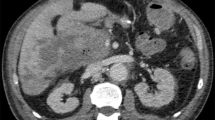Abstract
In the treatment of afferent loop syndrome, jejunostomy or Roux-en-Y gastrojejunostomy have tended to represent the preferred procedures. In patients who are not good candidates for surgery, palliative treatment—i.e., percutaneous transhepatic biliary drainage or percutaneous direct transperitoneal jejunostomy techniques—have been applied. Transhepatic biliary drainage confers a risk of ascending cholangitis. Direct percutaneous transperitoneal drainage may be impractical when overlying bowel loops prevent access to deeply located afferent loops. In the present case, percutaneous jejunostomy through the liver parenchyma was performed successfully for palliation of afferent loop syndrome.



Similar content being viewed by others
References
Yao NS, Wu CW, Tiu CM, Liu JM, Whang-Peng J, Chen LT. Percutaneous transhepatic duodenal drainage as an alternative approach in afferent loop obstruction with secondary obstructive jaundice in recurrent gastric cancer. Cardiovasc Interv Radiol. 1998;21(4):350–3.
Kim YH, Han JK, Lee KH, Kim TK, Kim KW, Choi BI. Palliative percutaneous tube enterostomy in afferent-loop syndrome presenting as jaundice: clinical effectiveness. J Vasc Interv Radiol. 2002;13(8):845–9.
Lee LI, Teplick SK, Haskin PH, Sammon JK, Wolferth C, Amron G. Refractory afferent loop problems: percutaneous transhepatic management of two cases. Radiology. 1987;165(1):49–50.
Maile CW, Hanna PD. Direct percutaneous drainage of an obstructed afferent loop. AJR Am J Roentgenol. 1989;152(3):521–2.
Gwon DI. Percutaneous transhepatic placement of covered, self-expandable nitinol stent for the relief of afferent loop syndrome: report of two cases. J Vasc Interv Radiol. 2007;18(1 Pt 1):157–63.
Moriura S, Takayama Y, Nagata J, Akutagawa A, Hirano A, Ishiguro S, et al. Percutaneous bowel drainage for jaundice due to afferent loop obstruction following pancreatoduodenectomy: report of a case. Surg Today. 1999;29(10):1098–101.
Morita S, Takemura T, Matsumoto S, Odani R. Septic shock after percutaneous transhepatic drainage of obstructed afferent loop: case report. Cardiovasc Interv Radiol. 1989;12(2):66–8.
Burke DR, Weinstein JK. Malignant jejunal strictures after Whipple procedure: stenting with large-bore tubes and use of combined transhepatic and peroral approach. Radiology. 1988;169(1):258–60.
Bezreh JS. Percutaneous catheter drainage of closed-loop small-bowel obstruction. AJR Am J Roentgenol. 1983;141(4):797–8.
Conflict of interest
The authors each declare that they have no conflict of interest.
Author information
Authors and Affiliations
Corresponding author
About this article
Cite this article
Kwon, J.H., Han, Y.H. Percutaneous jejunostomy through the liver parenchyma for palliation of afferent loop syndrome. Jpn J Radiol 33, 39–42 (2015). https://doi.org/10.1007/s11604-014-0372-3
Received:
Accepted:
Published:
Issue Date:
DOI: https://doi.org/10.1007/s11604-014-0372-3




